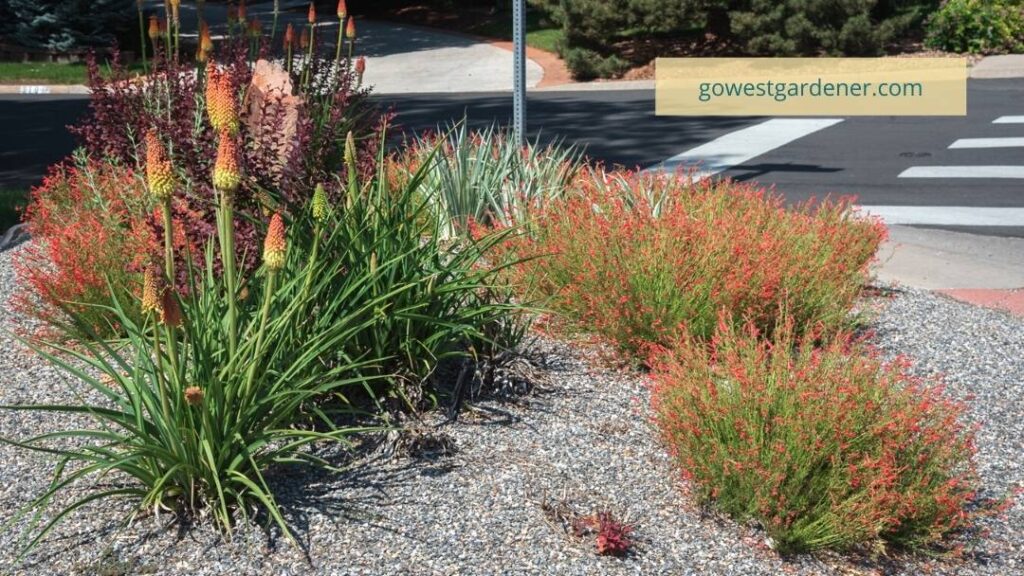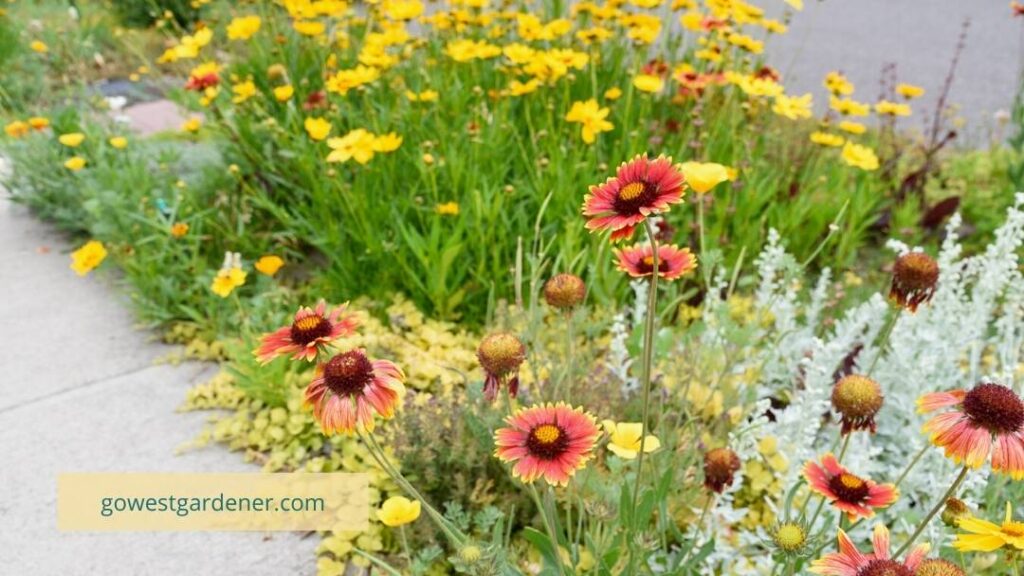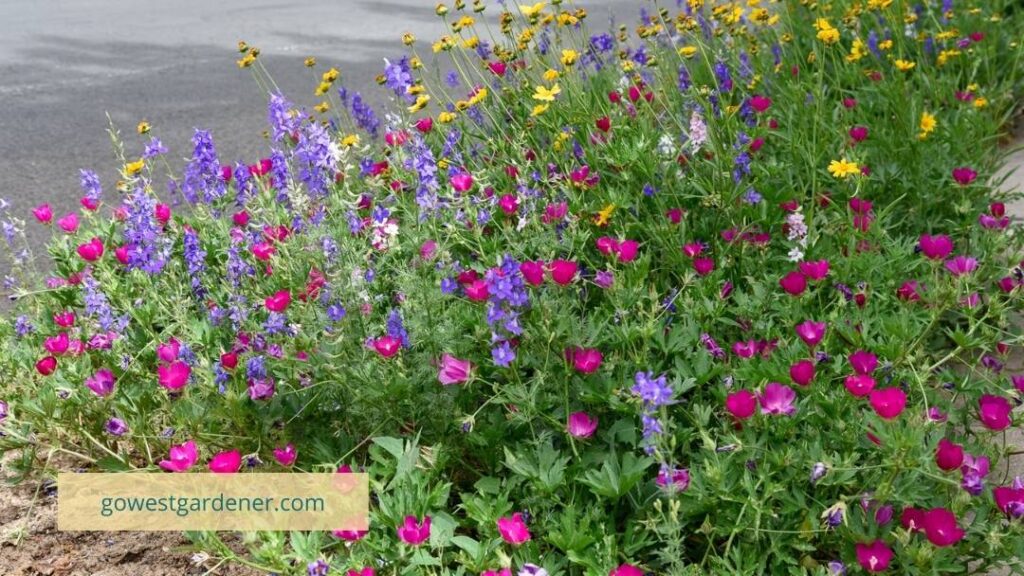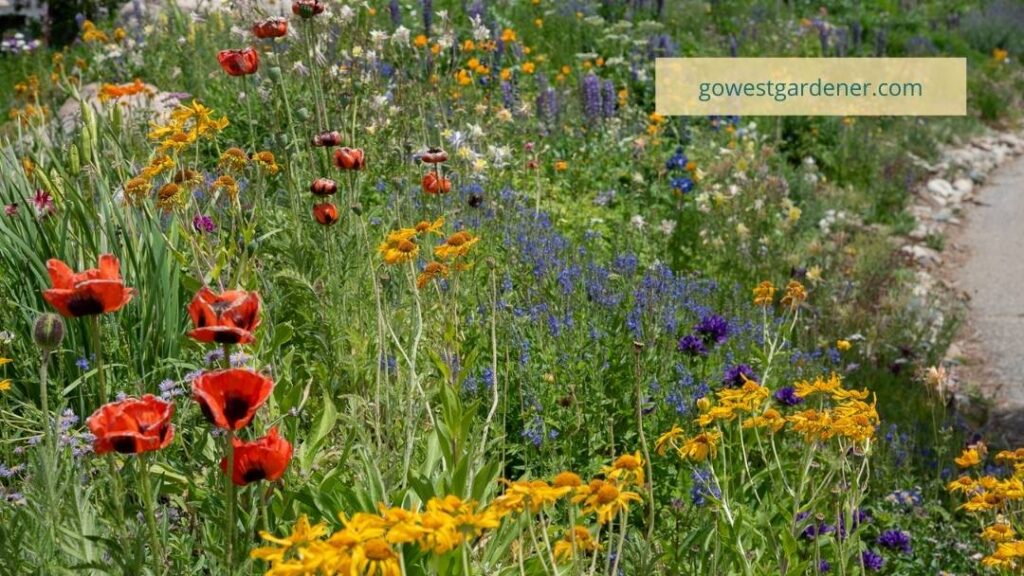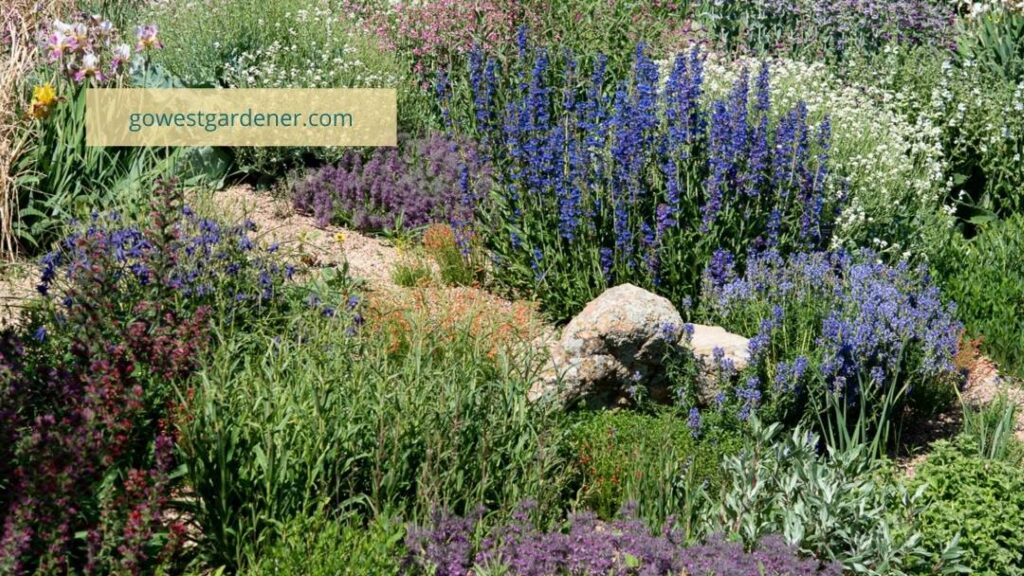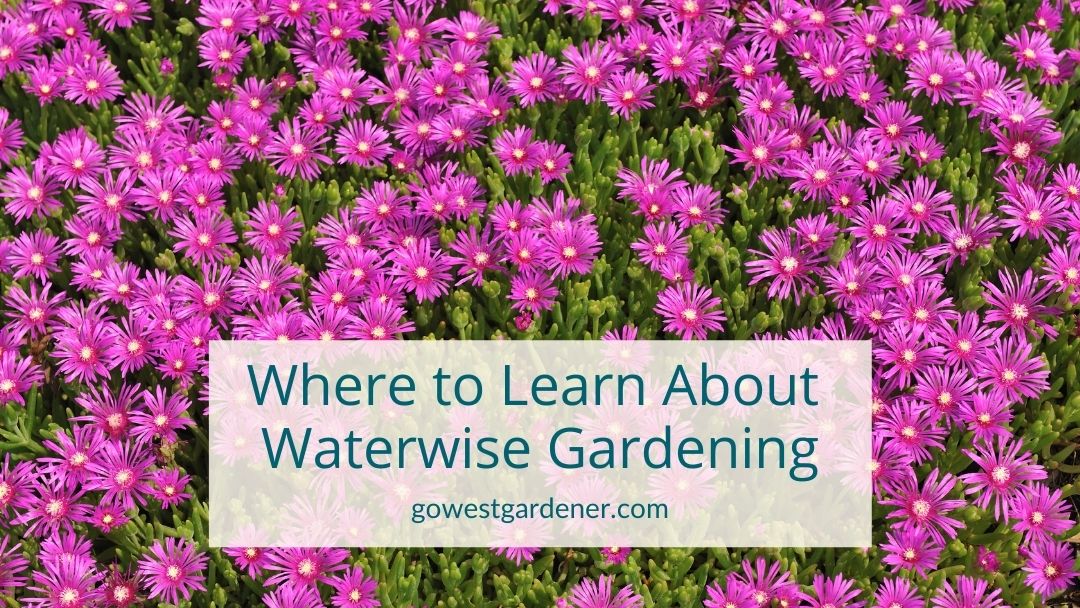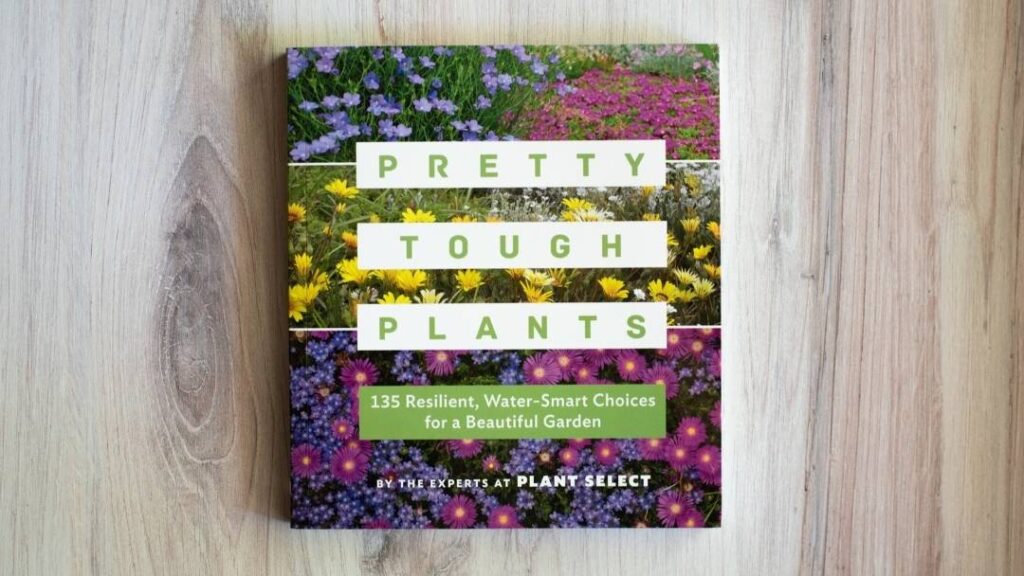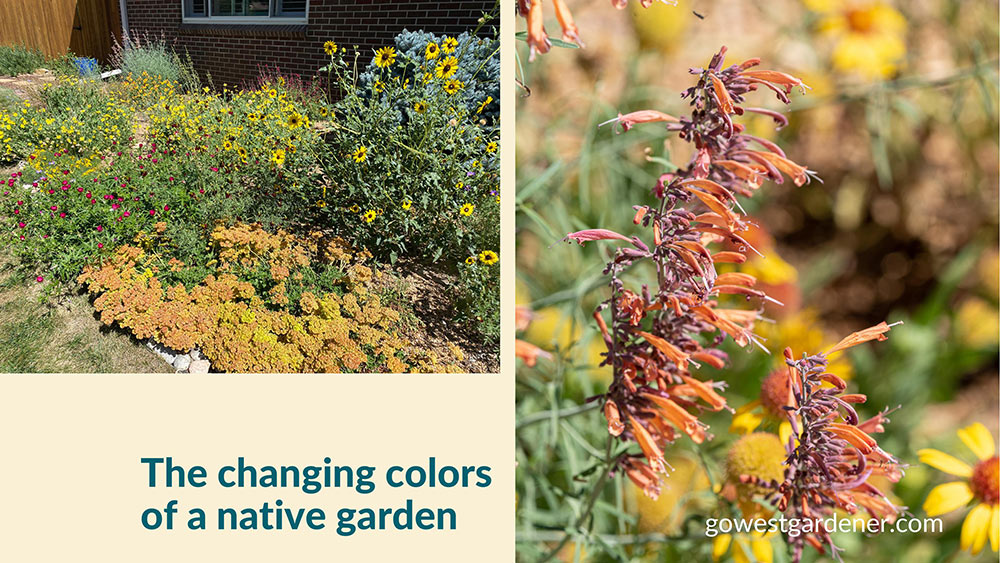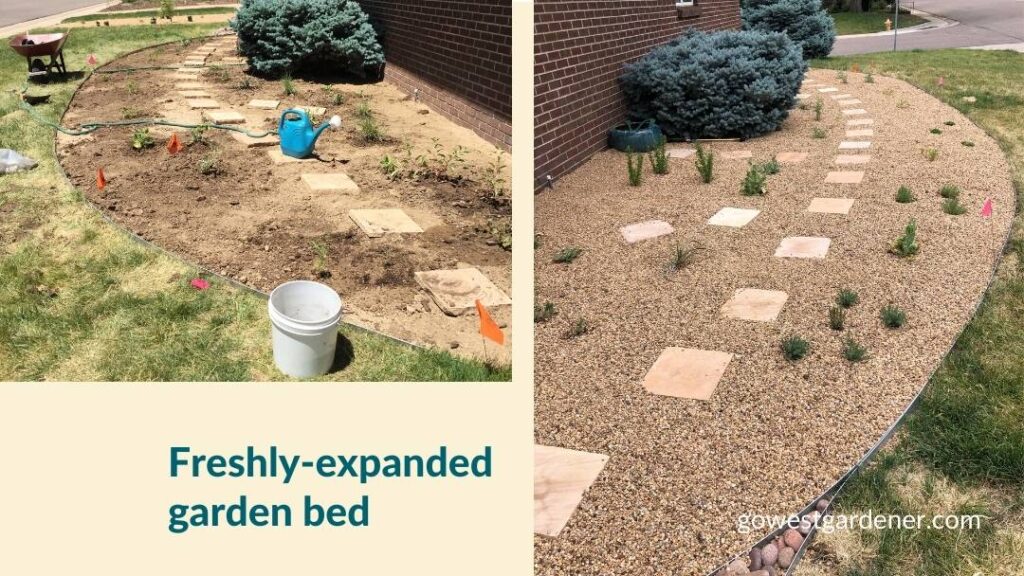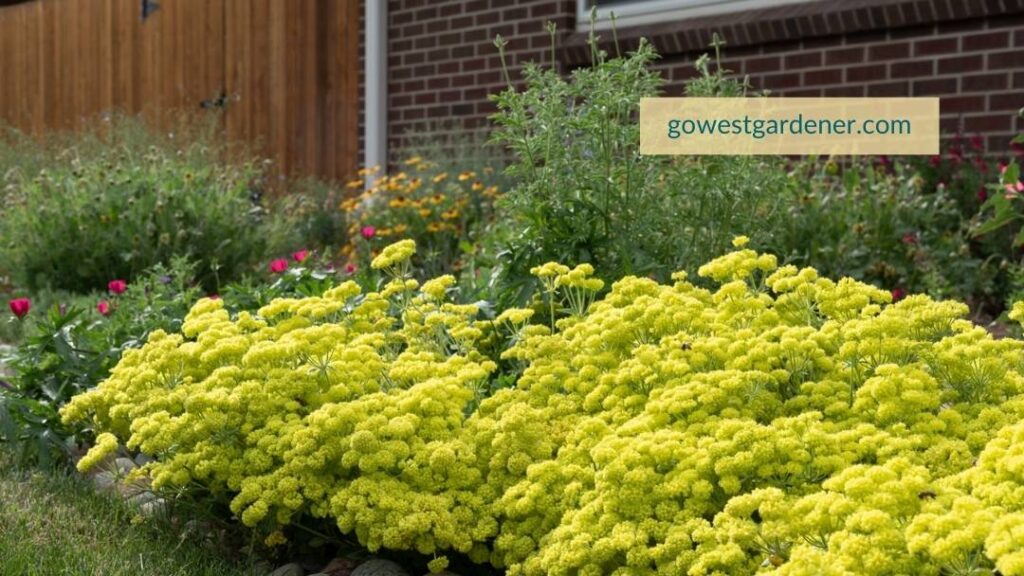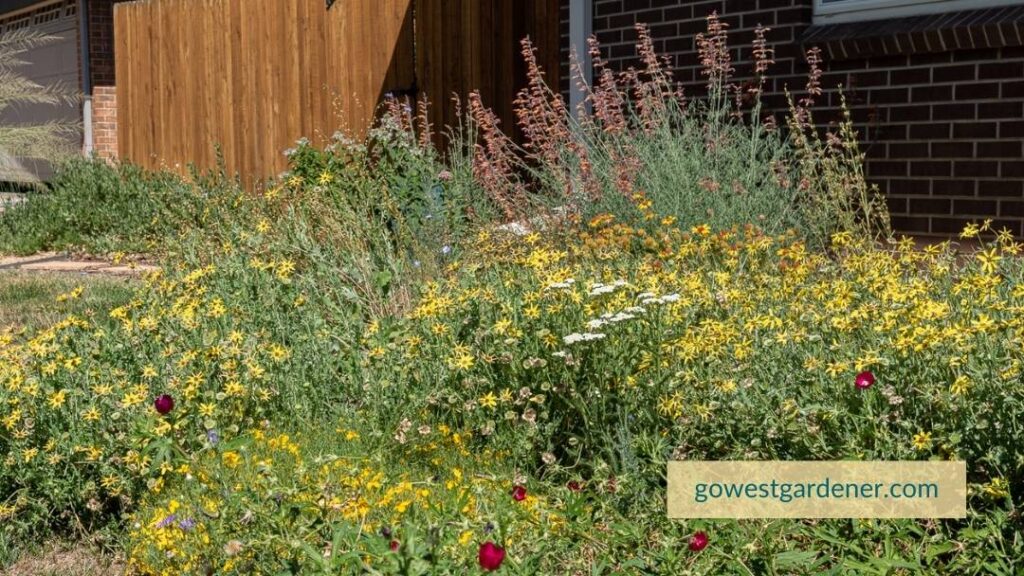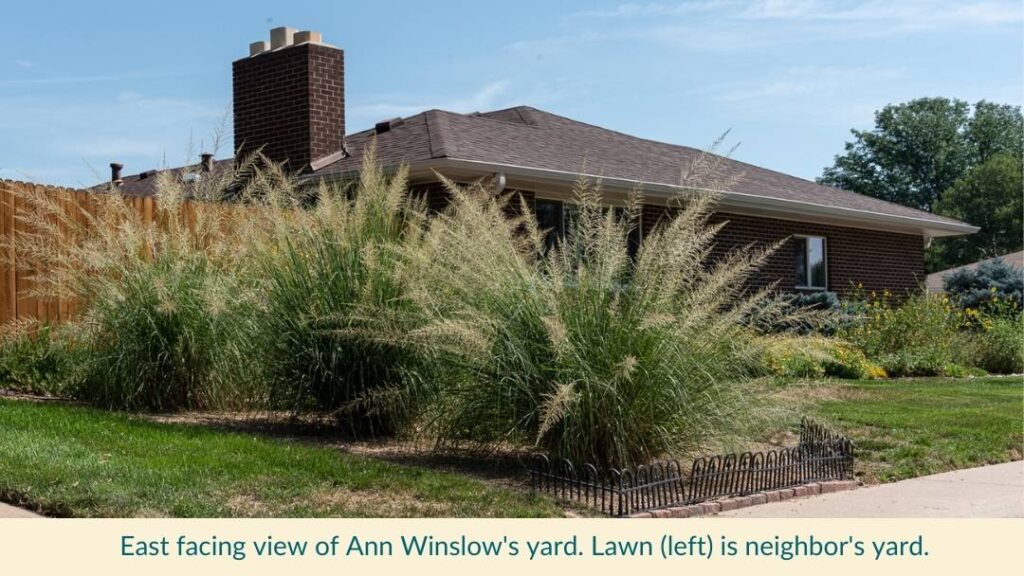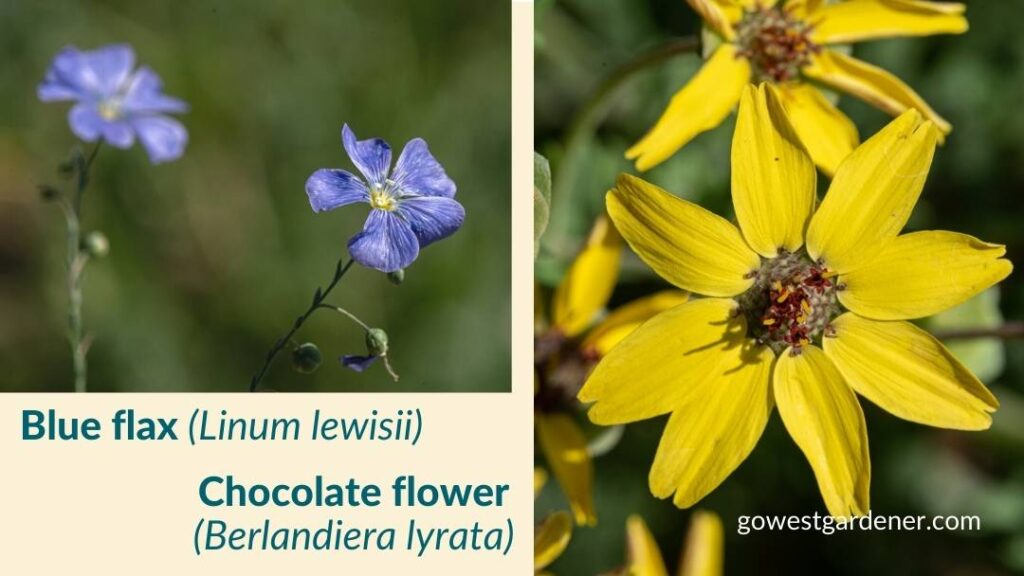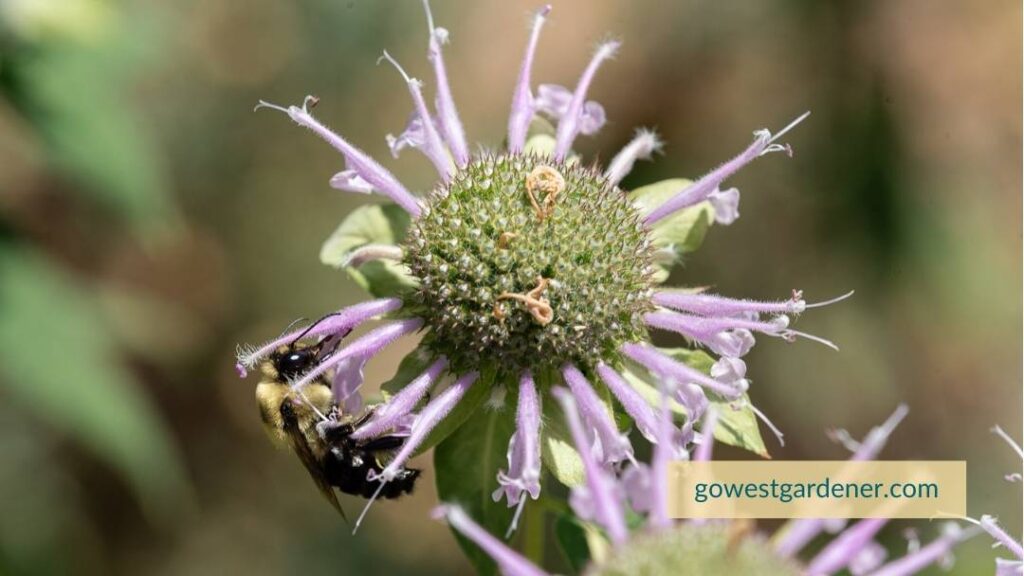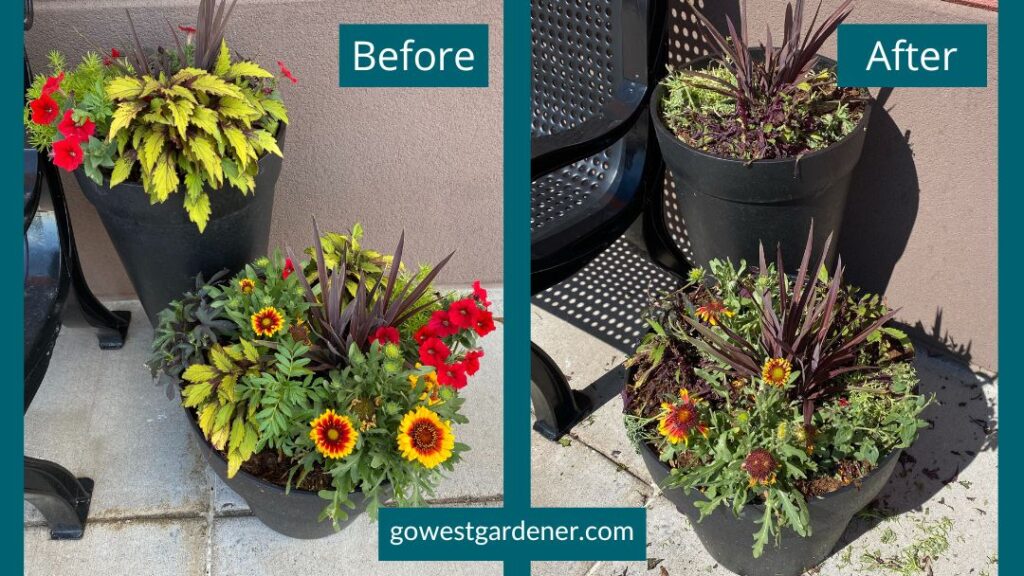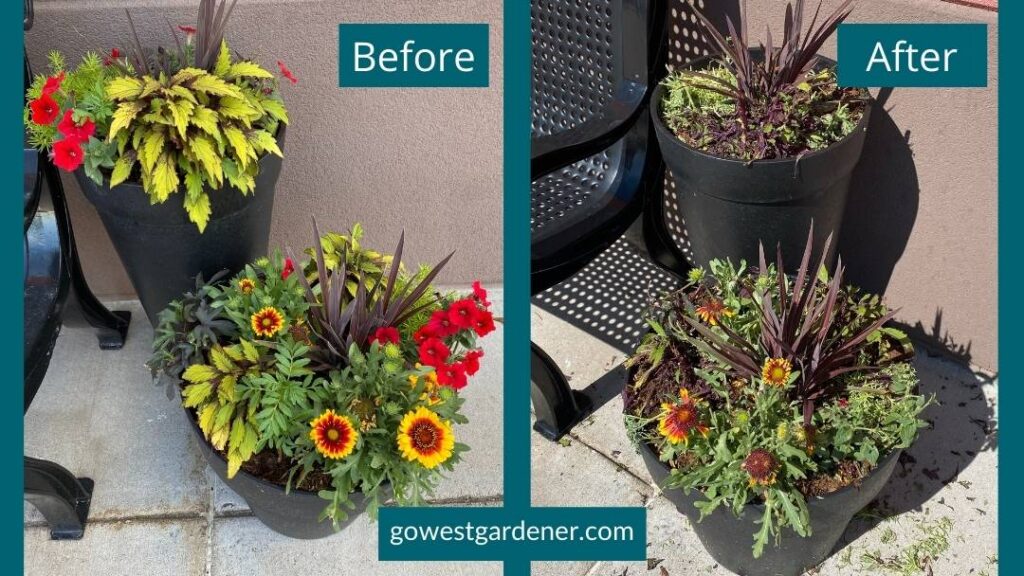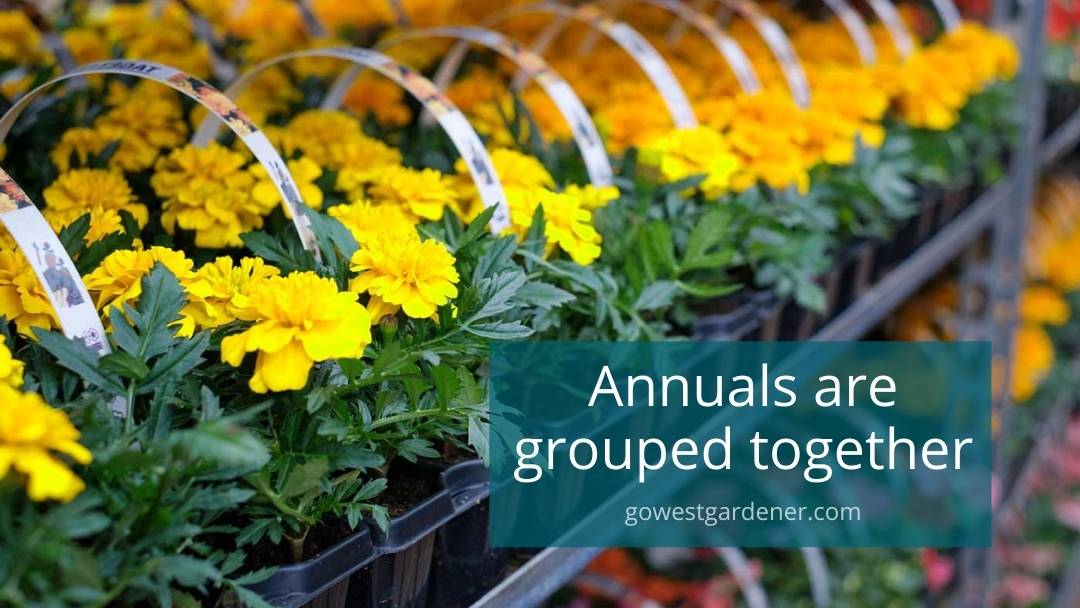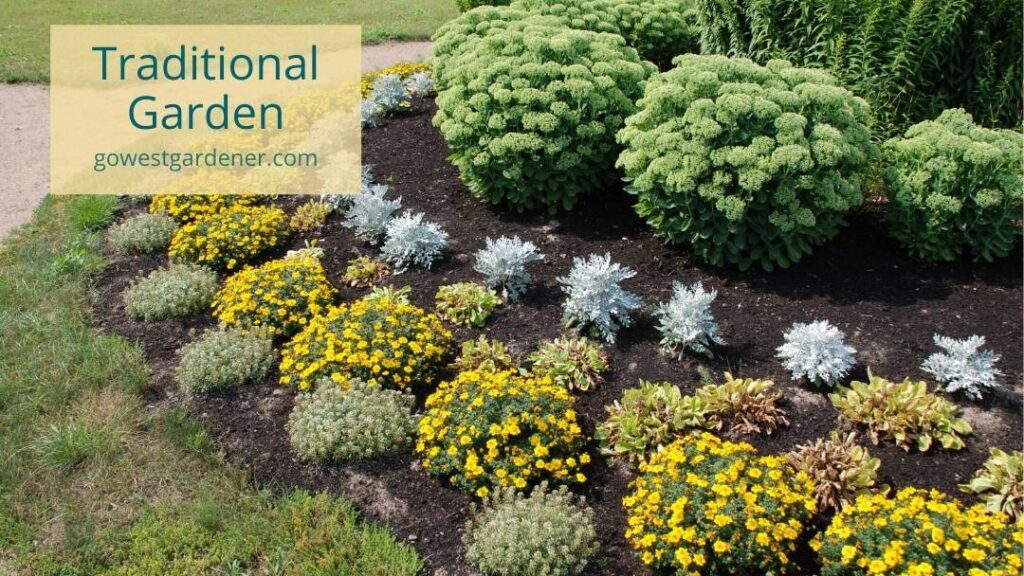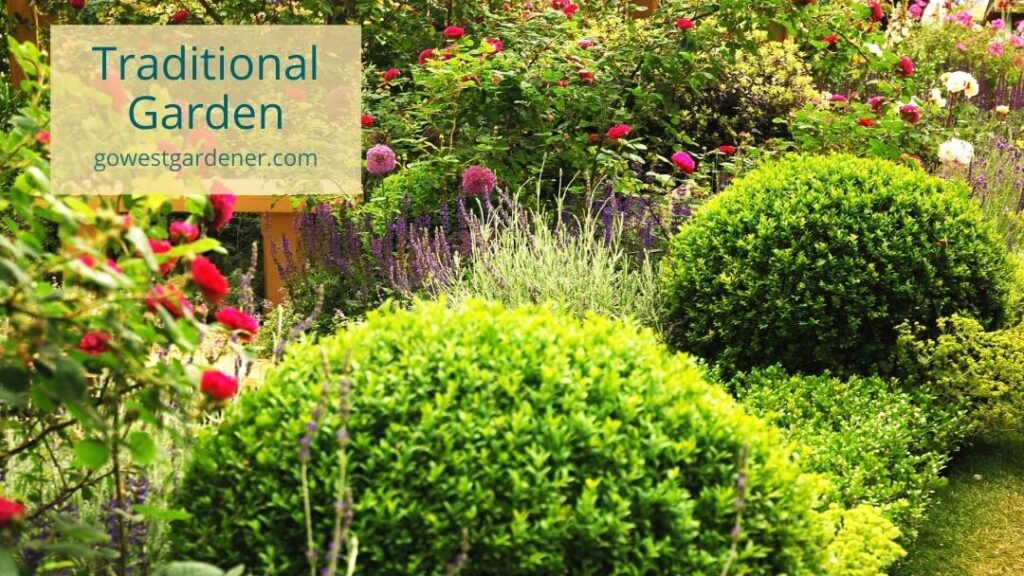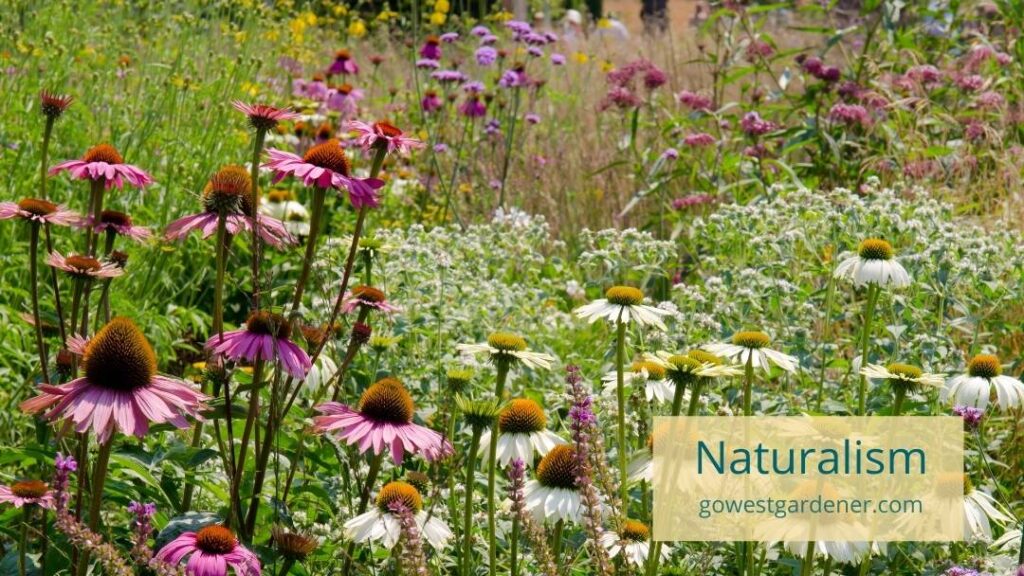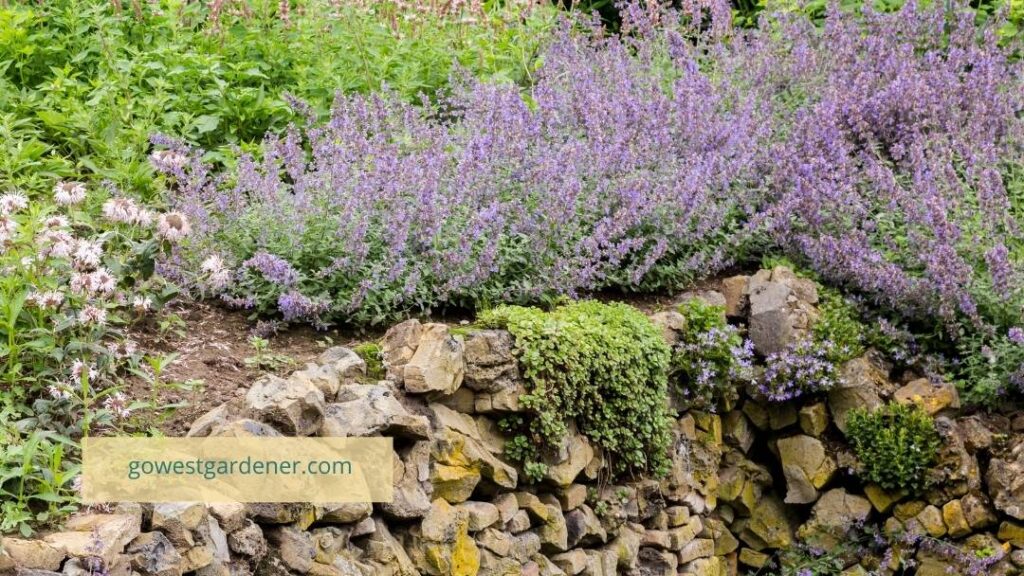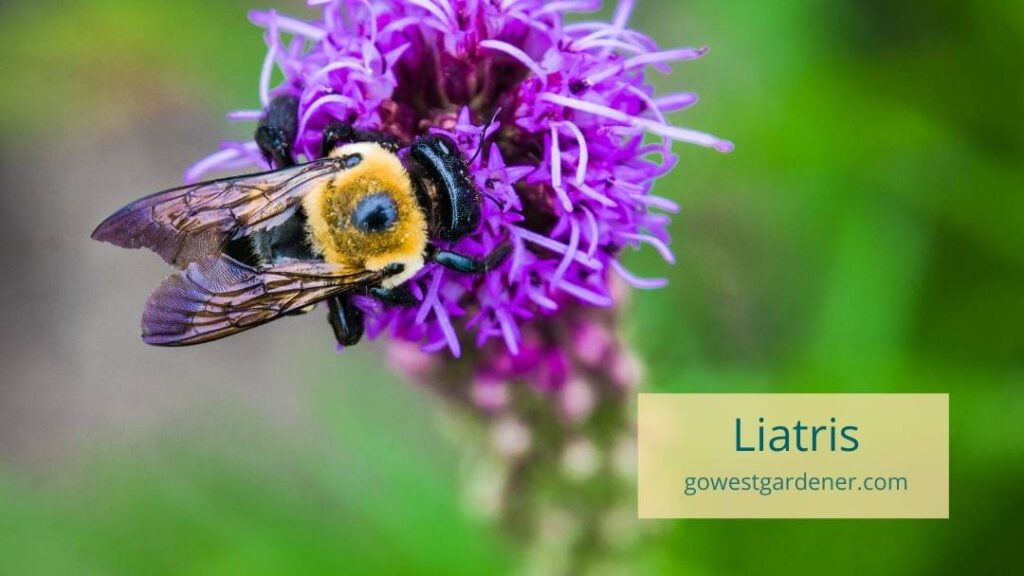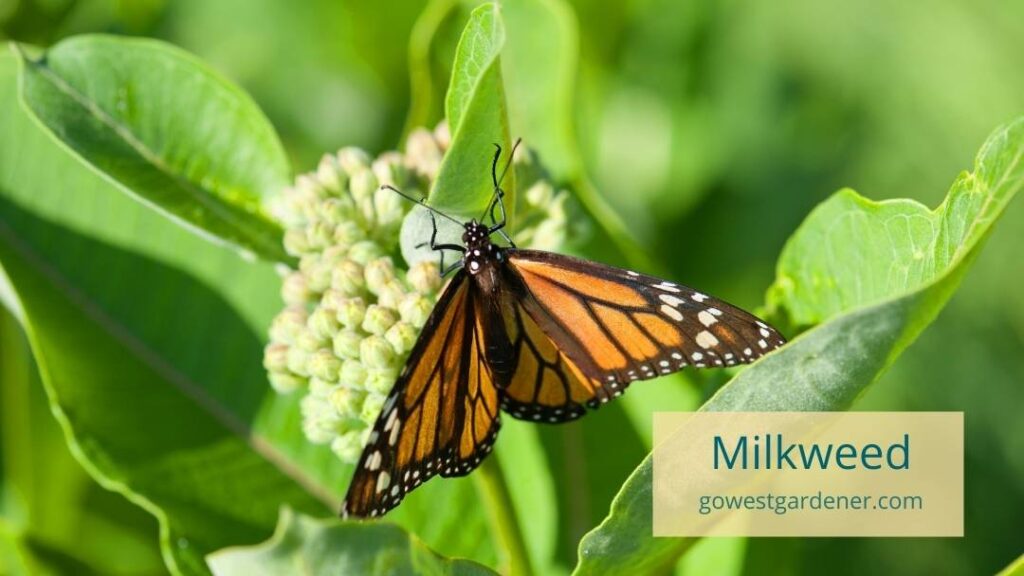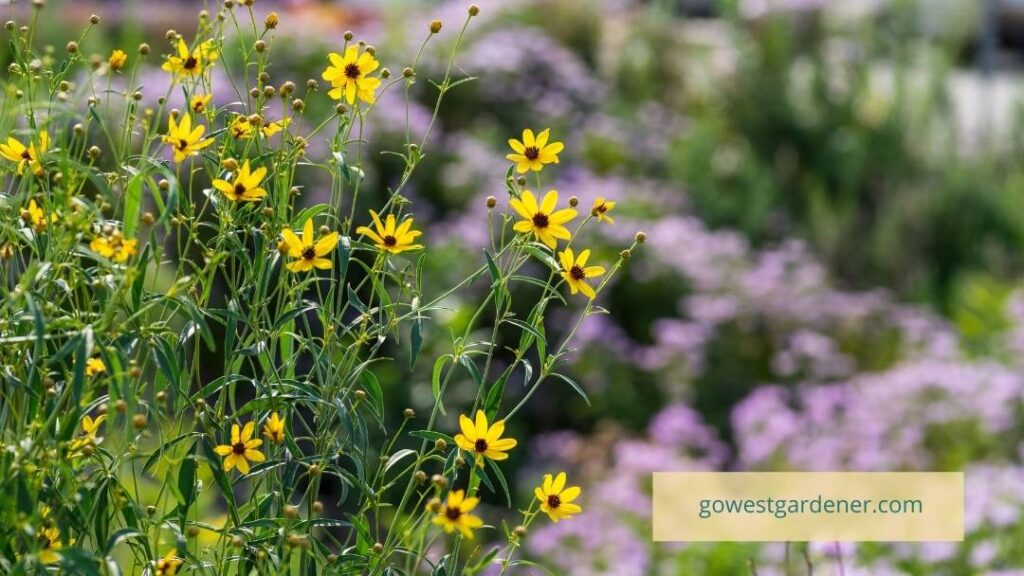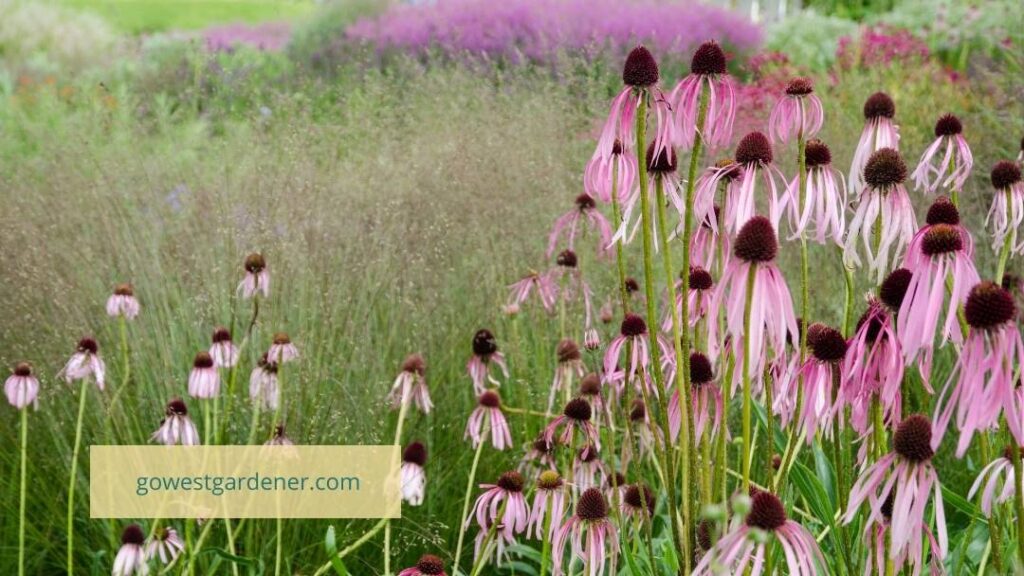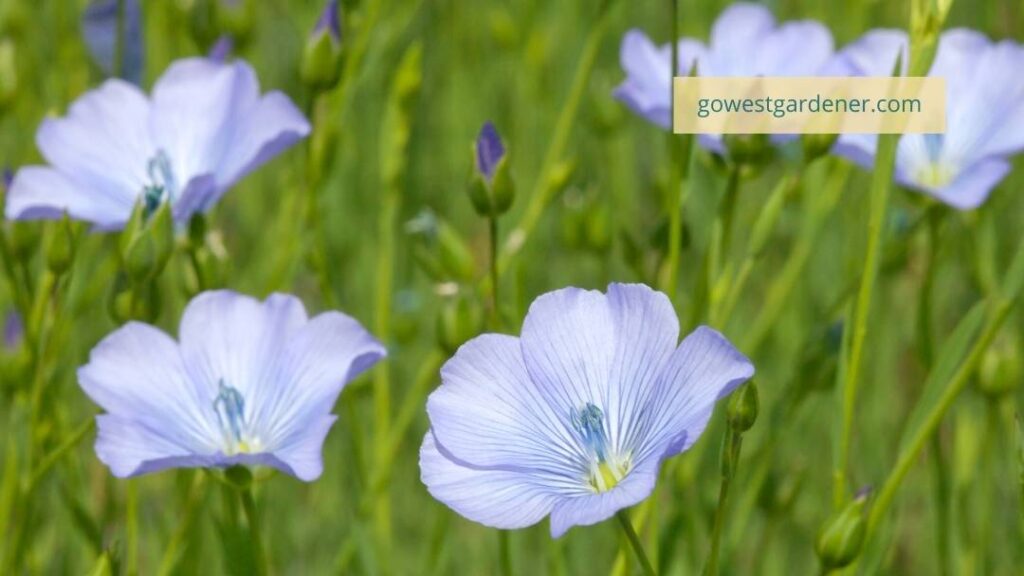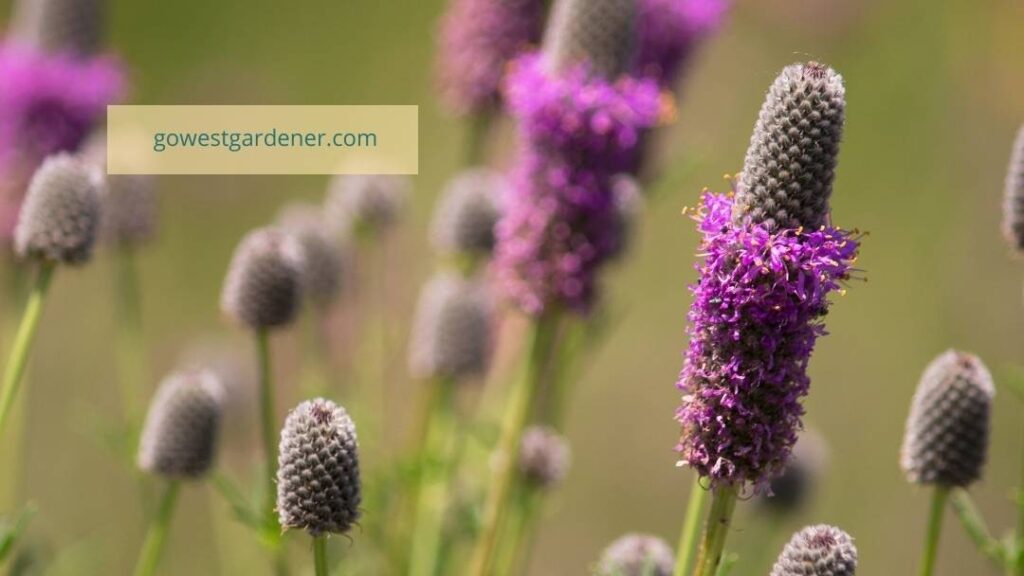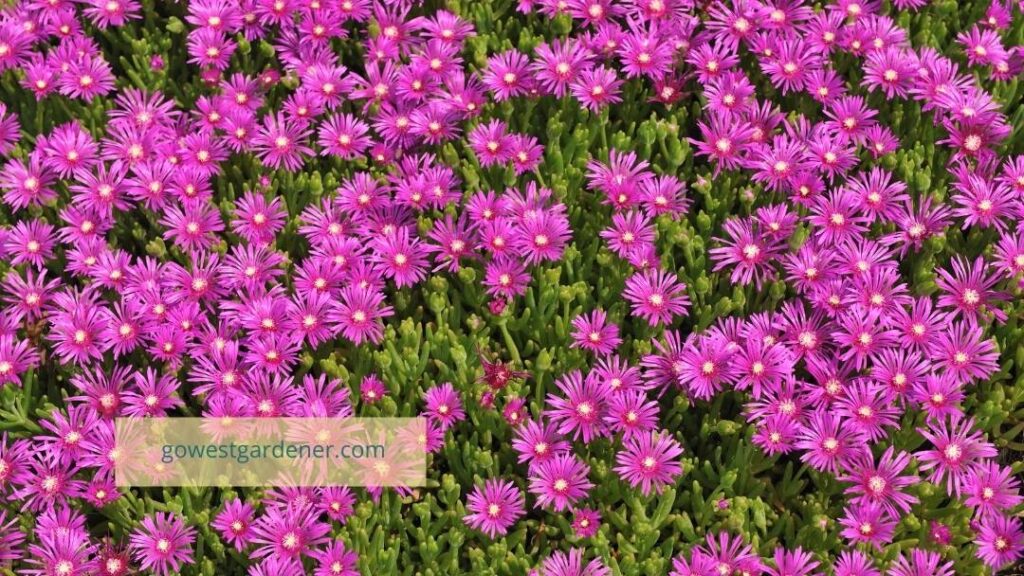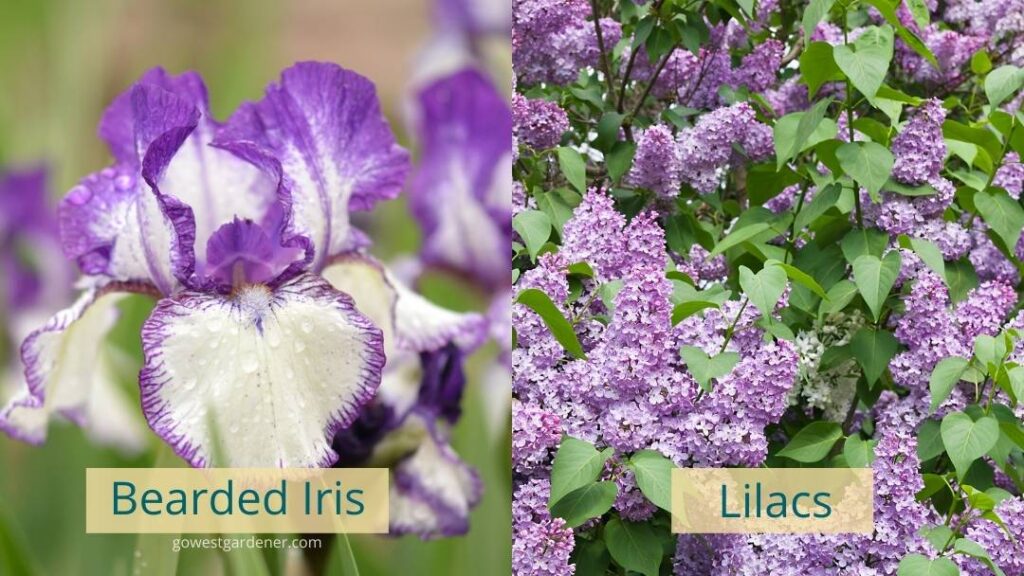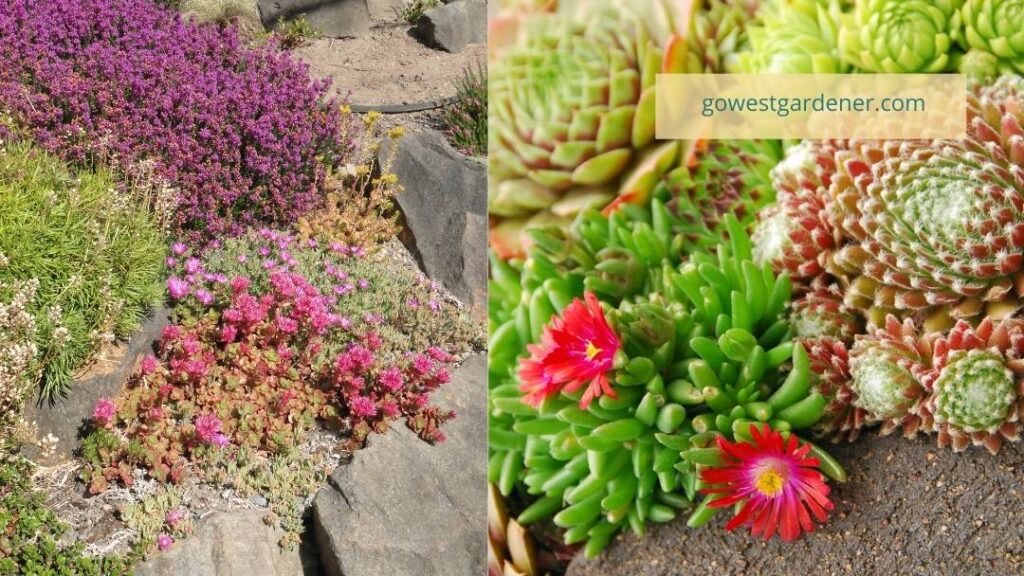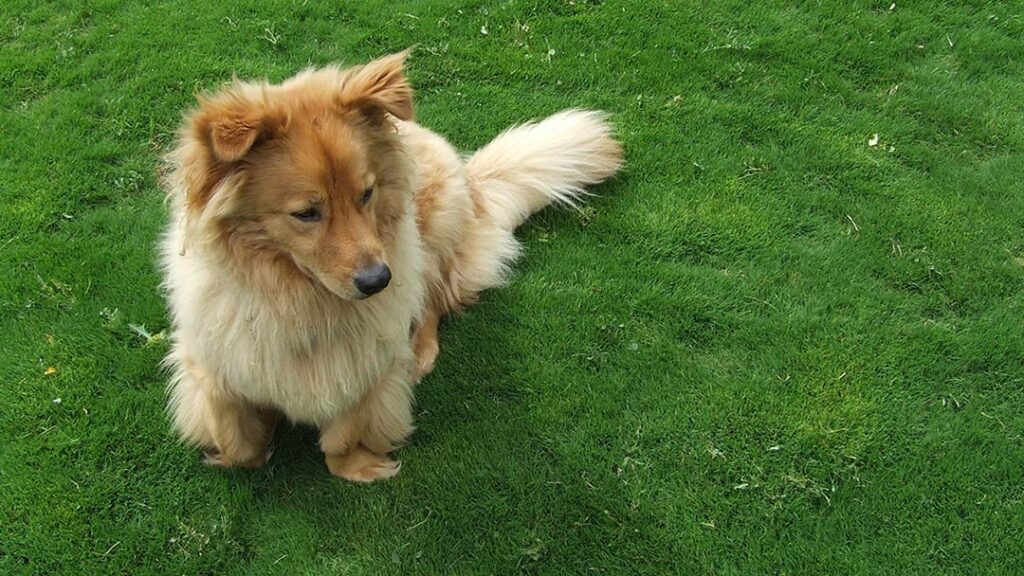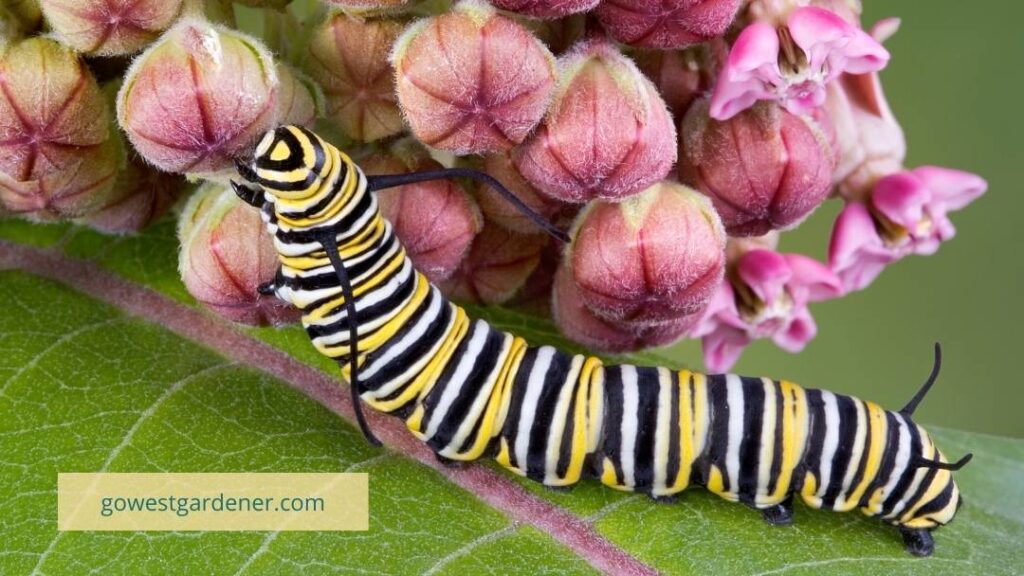
by Ann at Go West Gardener | Updated: Jun 20, 2025 | Gardening Tips and Tricks, Waterwise Gardening in the Intermountain West
Let’s say you’re thinking about planting a perennial garden in Colorado or a similar western state, so you can enjoy colorful flowers year after year. Yesssss!
Before you head to the garden center, here are a few things to know to get your western garden off to an amazing start—and some of these tips may not be what you expect.
1) Many perennials from other parts of the country aren’t the ideal fit for our growing conditions.
Growing flowers in Colorado, Utah, Idaho and similar states can be an adventure.
We have tricky soils (dirt), intense sunlight, roller coaster temperature swings, drying winds and low moisture. These conditions leave us grabbing for bottles of moisturizer and suntan lotion.
And they can be tough on plants too.
Flowers that thrive in places like the East Coast—where they get 40+ inches of moisture per year and have fertile, acidic soils—often aren’t a great match for our it-hasn’t-rained-in-2-months western gardens.
Instead, it helps to look for perennials that prefer the local growing conditions in your yard.
Before you buy flowers you know from other parts of the country (and yes, you’ll see them at the big box stores), explore flowers that grow well here. Check out websites like: PlantSelect.org, WaterwisePlants.org, and the Colorado Native Plant Society.
When you choose the right plants for the right places in your yard, you’ll be able to put your feet up and enjoy the beauty you’ve created—rather than making more work for yourself and racking up a hefty watering bill.
Speaking of watering…

2) Even drought-tolerant flowers need to be well watered their first year.
I learned this one the hard way when I planted my first perennial garden in Colorado.
Ahem.
Drought-tolerant flowers are plants that don’t need a lot of water to grow. However, they aren’t ready for our semi-arid conditions as soon as they’re planted. It isn’t instant.
Typically, they need consistent watering during their first growing season while their roots are getting established in the ground. Then, you can reduce how much you water them.
3) Buying smaller plants can (usually) give you bigger impact quickly.
Yep, you read that right.
There are perks to buying plants in smaller pots at the garden center, rather than getting the big, showy plants you see in larger containers. For example, smaller perennials with good root systems are known for getting established and growing faster than big plants.
Here’s why:
When your plants are small, they can put their energy into establishing their roots. And plants with healthy roots are more likely to survive our tough climate and push out new growth quickly.
(Not to mention… Smaller plants usually cost less and don’t use as much plastic in their containers. Win, win!)
Bigger plants, on the other hand, have more physiological stress after they’ve been planted. They have to support ALL the leaf, stem and flower growth that’s already on the plant.
And our climate doesn’t help.
Our high-elevation sunlight, semi-arid conditions and drying winds pull the water right out of them. Bigger plants can wilt or become stunted because they don’t have strong enough roots yet to support all of their above-ground growth.
So, when you head to the garden center to buy perennials, what plant size should you buy?
Denver Botanic Gardens suggests choosing perennials in quart-size containers. Quart-size containers are the pots you can hold in one hand. (You can find more of their western best practices for gardens here.)
4) Many western plants prefer soil (dirt) that isn’t rich and fertile.
Your soil—aka, your dirt—plays a big role in how happy and healthy your plants are.
In traditional agriculture, if you want to improve your soil, you typically add compost. (Compost is organic matter you can buy at the store or make at home from materials like leaves and food scraps.)
And yes, compost can be helpful, especially when you’re growing vegetables or perennials that thrive in other parts of the country, like the East Coast or the Pacific Northwest. These plants often like fertile soils.
But in western states like Colorado and Utah, this isn’t always the case. It depends on the types of plants you’re growing.
Drought-tolerant western flowers often prefer “leaner” soils that drain well. Lean soils may have a little organic material in them—but not much.
So what’s the takeaway here? If you’re planting a perennial garden in Colorado or Utah with western plants, the way that you get your soil ready will likely be different than if you’re planting a vegetable garden or a traditional perennial garden.
5) It may take a few years for your flower garden to reach its full glory. (This is normal.)
Perennials can take up to 3 years to reach their full size.
I mention this because it’s natural to plant a perennial garden in Colorado or Utah, and think, “This flower garden doesn’t look ANYTHING like my neighbors’ gardens.”
Trust the process. Your plants will grow, but it can take a year (or two) for your plants to get established.
Resist the urge to plant your flowers closer than is suggested. This will create more work for you later.
You’ll have a beautiful flower garden before you know it.
Related topics that may interest you:


by Ann at Go West Gardener | Updated: Jun 20, 2025 | Best Flowers for Colorado, Utah & Similar States, Flower Garden Basics, In-ground garden, Waterwise Gardening in the Intermountain West
If you’ve been wondering, “Where can I learn about plants for waterwise flower gardening?”, you’re in the right place.
It’s dry in the West, which means we need to be strategic about the flowers we grow in our gardens.
Where I live in Colorado, we’re lucky if we get 14″ of moisture per year. Depending on where you live, you may get even less!
Just to put that in perspective, Seattle and Chicago get close to 40″ of moisture per year. Boston gets about 44″ per year. And Atlanta and Orlando get around 50″ per year.
So, what is waterwise flower gardening?
Generally, waterwise flower gardening means two things:
- You intentionally choose flowers that don’t need as much supplemental water to grow. (No need to use the sprinkler today!) You may hear these plants called “drought-tolerant” or “low water” flowers.
- You group plants together that have similar watering and sunlight needs. For example, plants that need less water and a lot of sunlight go in one section of your yard. Plants that need more water go in a different section of your yard. That way, you’re being efficient with your irrigation.
While drought-tolerant flowers may make you think of cacti, rest easy, there are many beautiful flowers that grow well with less water.
They just may not be the flowers you know from other parts of the country!
To help you learn about waterwise plants, here are 4 useful resources.
I’m sharing the links below for your convenience only. You may be able to find the books locally.
1) “Waterwise Plants for Sustainable Gardens” (book)
Lauren Springer and David Ogden are western flower gardening experts. They have a wonderful book called: “Waterwise Plants for Sustainable Gardens.”
This is one of my go-to books for waterwise flower ideas.

It’s filled with photos and helpful tips that can be used whether you’re a beginner, intermediate or advanced gardener.
This book contains plant ideas for different regions of the semi-arid West, including the West Coast.
Pro tip: As you go through the book, make sure that the flowers you like match your plant hardiness zone. A plant hardiness zone tells you whether a plant is likely to survive the coldest winter temperatures that are expected in your area. Some of the flowers in the book may be better suited for parts of the West with warmer winters.

2) “Pretty Tough Plants” (book and website)
Wouldn’t it be nice if someone actually tested which low-water plants grow well in the intermountain west?
Good news, there are people that do!
Plant Select is a western plant introduction program. They introduce smart and sustainable plants that are inspired by the Rocky Mountain region. (They’re a non-profit collaboration between Colorado State University, Denver Botanic Gardens and the western green industry.)
Plant Select has a GREAT book called “Pretty Tough Plants.”
I refer to this book all the time. It’s another book that is user-friendly for gardeners of different levels. My understanding is this book is no longer in print, so if you can find a copy online, snag it!

Do you prefer online resources, rather than books?
You can see photos and descriptions of all the Plant Select flowers on their website, including both flowers and shrubs.
And if you’d like to see these flowers in person…
You can find Plant Select demonstration gardens across Colorado and in some additional western states.
I’ve visited a number of the demonstration gardens in the metro Denver area. My favorite Plant Select garden is at Denver Botanic Gardens Chatfield Farms. It’s beautiful.
I’ll share upfront, some demonstration gardens are better than others, and the plants aren’t always marked.
So, if you’re just getting started with waterwise gardening, my suggestion is to visit the Plant Select demonstration gardens at your local botanic gardens. That way, you can ask what a flower is if you like it. We’ll chat about plant identification apps in a future tip, but you can always try identifying plants with plant ID apps too.

3) Online workshops, videos and low-water plant lists
Colorado Springs Utilities has a number of helpful resources on gardening with less water.
On their waterwise plants website, you can find links to:
- A variety of online workshops, including a video called “Waterwise Landscaping for Beginners”
- Photo galleries of waterwise landscapes
- Low-water plant lists
While the online workshops are tailored to Colorado Springs residents, many of their waterwise gardening tips are relevant well beyond.
This is a website worth checking out, regardless of whether you live in Boulder, Boise or Cheyenne.

4) Native plant lists and tips
Native plants are plants that have occurred naturally in a region. They were there before European settlement. They’ve adapted to local growing conditions, and they can provide great habitats and food sources for birds, insects, etc.
Many native plants are drought tolerant. (Though, not all of them.)
If you’d like to learn more about drought-tolerant native plants, your state probably has a “Native Plant Society.”
Here are the native plant societies for the intermountain west:
If you don’t see your state listed above, simple google: [Name of your state] Native Plant Society.
In Colorado, the native plant society has a dedicated resource page for gardening with native plants in Colorado. You’ll find their plant guides for every region in the state. For example, they have suggestions for low-water, native plants for the Front Range of Colorado. You’ll also find their recommendations for flowers to avoid planting because they can be invasive.
Related topics that may interest you:


by Ann at Go West Gardener | Updated: Jun 20, 2025 | Gardening for Pollinators, Gardening Tips and Tricks, In-ground garden, Waterwise Gardening in the Intermountain West
I first published this article in 2022. I hope you find it helpful!
I would love to introduce you to Ann Winslow. (Yep, another Ann!) She spent time creating a native pollinator garden in her Colorado yard during the Covid shutdown in 2020.
She wanted to attract more pollinators—like native bees and hummingbirds—to her yard, so she decided to create a garden using native plants.
If you’re new to native plants…
They are plants that have naturally existed in an area for hundreds of years. They weren’t introduced through the European settlers.
Many of the flower plants we find at the garden center can trace their heritage back to places like the East Coast or Europe, where the climate, local insects and wildlife can be quite different.
Native western plants offer high-quality sources of food and shelter for native bees, butterflies, birds and more. These plants and critters have evolved together and sometimes depend on each other.
Ann kindly agreed to let me interview her and share her story—from her tips on creating a native pollinator garden in Colorado, to the lessons she learned, to what she would do differently next time.

Go West Gardener (GWG): Ann, thanks so much for sharing your garden with me today.
Ann Winslow: My pleasure!
GWG: Why did you decide to create your garden?
Ann W: I wanted to attract and support native pollinators.
I’ve read several books by a man named Doug Tallamy that were life changing for me. His recent book, Nature’s Best Hope, is all about how to create environments in our yard that are supportive to pollinators. He suggests looking at our yards as small national parks that can serve as wildlife habitats.
GWG: When did you create your native pollinator garden?
Ann W: Back in 2020 during the summer of the lockdown. It was a crazy time, but it was wonderful therapy to be creating a garden in Colorado.
GWG: So true! I think a lot of us spent time outside in our yards. Have you ever created a pollinator garden before?
I created a waterwise garden at my last house, but no, this was my first time trying anything like this.
GWG: I understand that some of your yard was lawn before you started. How did you go about getting rid of your grass?
Ann W: We hired a local guy who dug it up with shovels.
The garden bed existed from the previous homeowners, but we changed the shape and took out some grass. We also took out the turf grass on our property next to our neighbor’s house.
And my husband and I removed most of the existing shrubs and an overgrown arborvitae.

GWG: How did you go about figuring out which native plants you wanted to include in your garden?
Ann W: I looked for plants that were native to Colorado first. Then, I branched out to plants that were native to our region of the country.
I started with the plants that the Colorado Native Plant Society and the Colorado State University Extension talk about on their websites. I also looked at the City of Boulder and City of Fort Collins websites because they have helpful information for their citizens.
I used Plant Select too.
Plant Select is a non-profit collaboration between Denver Botanic Gardens and Colorado State University. They test and select plants that thrive in the high plains and intermountain west, including native plants.
The main thing I looked for was whether the plant had a simple flower that pollinators could get into. If a flower bloom is too profuse, sometimes the pollinators can’t get in there.

Photo caption: Several of the plants in Ann’s native pollinator garden in Colorado
GWG: What if people don’t have a lot of time to do research on native plants?
Ann W: I got a Garden in a Box from Resource Central for one of my other gardens, and it was a great solution. It’s a pre-planned garden for Colorado, and it comes with a design for your plants. Many of their pre-planned gardens include native plants.
GWG: Did you do anything special to get your garden ready for your plants?
Ann W: The native plants that I planted on the south side of my house like drier conditions. So, the only thing I did was mix about one-third expanded shale into some of the plant holes I was digging. I found the expanded shale at Harlequin’s Gardens in Boulder.
Expanded shale is like a lightweight, porous gravel that can get mixed into the soil [dirt] to help with water drainage and soil oxygen.
I have heavy clay soil. My prairie plants seem to love the clay—I think that may be why my prairie zinnia is doing so well.
But for some of my other plants, they need better drainage and more air around their roots. That’s where the expanded shale helps.
GWG: How did you go about designing your native pollinator garden? Did you hire a landscape designer?
Ann W: No, I didn’t hire a designer. I went online for designs.
I was looking for something similar to what I wanted to do in my garden, which was to extend the bed into a large semi-circle. I looked for similar designs and got some plant ideas from there. I also looked at how they placed plants.
The Colorado Native Plant Society has some simple designs for various regions across Colorado. They have ones for the plains, the foothills, the montane region and more. I looked at their designs for the plains and foothills and worked with those.
The City of Fort Collins had designs online. And Plant Select has garden designs online too.
And I recently saw that Wild Ones Front Range has a native garden design on their website too.

GWG: Knowing what you know now, what would you do differently if you could go back in time?
Ann W: If I could go back, I would take more time with upfront planning.
I’d tell myself to take the time to really get to know my site and what kind of sunlight it gets. Go outside several times per day and at different points in the spring and summer to see how the sunlight is. Be aware of how things may shade the garden, like overhangs from your house or trees that may be 10 feet away.
I thought I knew my sunlight, but I think being more thorough would have been helpful. I have some plants reaching for the sun and others that didn’t make it because they didn’t get enough sun.
GWG: That’s a great tip. What else?
Ann W: I’d also tell myself to buy fewer plants and see how things go.
I think I overbought, and having invested the money, I felt like I needed to get all the plants in the ground. I ended up planting things too close together. The blue flax [flowers] are not as pretty as they could be because the plants are so close together. They’re one large mass. Their lovely shape and ferny look can’t be appreciated.
And I’d pay more attention to how irrigation affects the garden, even if we aren’t directly spraying it with water. Many native plants prefer low water, so you have to be careful with how the irrigation system for your lawn butts up to your garden.
And how does your neighbor’s watering affect your plants? Does their water drift over? We have a few plants that are probably getting more water than they prefer and may not live as long.

GWG: I’ve never thought about how my neighbor’s sprinklers can affect my plants, but I can see how that’s important to consider. On the topic of water, how often do you water?
Ann W: I haven’t watered the entire garden once this season [as of late June 2022], even with the heat and dry periods we’ve had this summer in Colorado.
But I have watered some individual plants—like anything that’s newly planted, the hyssop [Agastache rupestris] so it has plenty of blooms for the hummingbirds, and a native bee balm [Monarda fistulosa] that just showed up.
But even with those plants, I’ve only watered them maybe once a week if we haven’t had a soaking rain.
GWG: Wow, that’s awesome! What about when you first planted your garden?
Ann W: That first summer, I watered the plants by hand just about every day from June to mid-July to help them get established.
After that, I cut back the watering to about twice a week.
GWG: What’s your favorite plant in your native pollinator garden and why?
Ann W: I’d have to say chocolate flower [Berlandiera lyrata]. It’s a profuse bloomer. The pollinators love it. It smells good…
GWG: Like chocolate!
Ann W: Yes!
It’s very hardy, and it spreads.
I also really love the blue flax [Linum lewisii]. You don’t find a lot of flowers that are blue. I like the airiness, and the small bees seem to really like it.
GWG: What are some of the other plants that are thriving in your garden?
Ann W: The prairie zinnia [Zinnia grandiflora] is thriving.
The blue grama grass [Bouteloua gracilis]—it’s given us numerous volunteers.
The Kannah Creek buckwheat [Eriogonum umbellatum var. aureum]. It has a beautiful, mounding shape. It has yellow flowers in the spring, and then the foliage turns burgundy in the fall through winter.
The Sunset hyssop [Agastache rupestris]. I’ve seen hummingbirds visiting it.
The hummingbirds also like the Furman’s Red sage [Salvia greggii] and the red yucca [Hesperaloe parviflora].
And the blanket flower [Gaillardia aristata]. It’s a prolific bloomer, and the bees like it. I’ve seen Spotted Towhees [western birds] scratching around it, looking for insects.
GWG: What do you like most about having a native pollinator garden in Colorado?
Ann W: It’s the pollinators. Because it’s alive, it fills my heart with joy. I feel like I’m helping in some tiny way.
We see a lot of variety in the bees visiting the garden. Big bees. A lot of small, native bees. You can see hundreds of insects buzzing around in the late-day sunlight.
And we get those Spotted Towhees [western birds]. That’s been a bonus we didn’t expect.
GWG: What advice do you have for people who’d like to create a native pollinator garden?
Ann W: I’d say do your research.
Talk to people who are knowledgeable about native plants. I think it would have been helpful if someone had said, ‘You have too many plants in here and it’s going to get really crowded. You need to take some plants out.’
You just want to pop all the plants in the ground and say, “Go do your thing!” but it does take some thinking and planning.
GWG: I can relate to that. It’s tempting to want to jump into buying plants, but planning makes things easier later. What other tips do you have?
Ann W: I’d say write down what your plants are and keep track of what you’re learning. You will make mistakes. That’s been hard for me to acknowledge. I’m a perfectionist—I want to get it right from the start.
The magical thing about it is you see what nature does on its own. You find yourself saying, “Wow, I did nothing to that and look what happened.” That’s another reason it may be a good idea to not buy too many plants in the beginning.
GWG: And you mentioned irrigation earlier…
Ann W: Yes, think about your irrigation.
If you want to remove your grass but you have trees, you need to have a drip irrigation system for your trees, so they can still get water. Group your plants together by their water needs.
And talk to your neighbors upfront and tell them what you’re doing.
Initially, the neighbors next door weren’t very excited about what we were doing. You have to turn your sprinkler system off while you’re creating the garden, and our lawn suffered for a little while. But we talked to them and explained what we were doing, and they were okay.
By mid-summer, the lawn was fine.
GWG: What kind of reaction do you get from neighbors now?
Ann W: People stop by and say, “That’s really pretty!”
GWG: I agree with your neighbors, Ann, and it’s cool to see so many types of bees. Thank you for sharing your great tips for creating a native pollinator garden in Colorado.
Ann W: It’s been a pleasure to talk with you about this!
If you love having a garden…
… that’s buzzing with activity (hummingbirds, butterflies, bees or other pollinators) or you want to create a garden with pollinators in mind (many of whom are losing their natural habitat), put native plants on your radar.
You can start from scratch like Ann did.
Or, you can simply work native plants into your garden as you can, especially if you have an existing garden. These plants are surprisingly adaptable to different garden styles.
And if you’d like to learn more about Ann’s yard transformation…
… she wrote a series of articles about her experiences below:
Related topics that may interest you:


by Ann at Go West Gardener | Updated: Jun 20, 2025 | Gardening Tips and Tricks, Western Container Gardening With Flowers
9 ways to prepare for hail to minimize damage to your western garden
Hail can leave you wanting to yell, “WHHHHYYYYYYYY?????” to Mama Nature. Sometimes, thunderstorms pop up so suddenly, there’s very little that can be done except for cleaning up the damage.
But other times, you may see thunderstorms in the forecast, and you can plan ahead.
In this tip, you’ll find options for how to protect your flowers from hail.
With a little planning, you can reduce hail damage and keep your sanity (and garden) intact.
Here’s how to protect your flowers from hail.
#1: Plant drought-tolerant flowers in your garden.
One of the easiest ways to minimize hail damage and reduce your clean-up after a hailstorm is to plant drought-tolerant flowers. These waterwise plants are more than just pretty. Many of them are as tough as heavyweight champs.
You’ll see a couple examples of drought-tolerant flowers that are more resistant to hail below, such as Coreopsis and Salvia (sometimes called Meadow Sage).


Find out why drought-tolerant plants are more resistant to hail and see examples here >>
#2: Plant your annuals in flowerpots, rather than in the ground.
Annuals are your flowers that bloom for one summer, but typically don’t return.
Unfortunately, they tend to be vulnerable to hail.
When you plant your annuals in pots, you can keep them on covered porches or under overhangs, so they’re out of harm’s way. If you want to put your pots in your garden, you can quickly move them to a protected spot in a hailstorm (assuming the pots aren’t too heavy).
I pull my pots under an overhang on our porch when severe thunderstorms are in the forecast or when I see red storm cells approaching on the radar.

#3: Proactively move your flowerpots to a protected spot if hail is in the forecast.
I know some of your pots may be too heavy to move, so let’s focus on your pots that aren’t too heavy.
You may want to get “plant caddies” to help you.
Nope, you aren’t recruiting anybody from the local golf course.
Plant caddies are devices with wheels that make it easier for you to roll your pots. I keep my flowerpots on plant caddies all the time. That way, I’m ready to roll them when bad weather is coming in.

The home improvement stores often carry plant caddies. You also can google them to find more decorative versions.
If you can pull your pots under a tree, that sometimes helps too.
#4: Cover vulnerable plants in your garden when hail is in the forecast.
Get creative!

You can use a variety of materials to cover your vulnerable plants.
For example, you can:
- Cover your plants with trash cans, laundry baskets, cardboard boxes, buckets, empty flowerpots and plastic storage bins turned upside down.
- Use outdoor lawn furniture to cover your plants.
- Hang fabrics and netting that protect against hail.

Some netting is specifically made for hail, like “anti-hail netting.” But these fabrics can be hard to find when you need them, and they can be pricey.
So, don’t be afraid to get creative!
I know many gardeners who use other fabrics, such as breathable netting from a fabric store or metal hardware cloth.
I even have one neighbor who makes tents over her flowers with old shower curtain liners.
(How’s that for creative?)
Ideally, what you’re trying to do is reduce the force of the hail and lower its kinetic energy, so it does less damage.
Hopefully this goes without saying, but don’t use anything as a cover that you don’t want to get destroyed. If your hailstorm is intense enough, it can damage just about anything.
#5: Don’t cover your flowers for long amounts of time.
If you’re using something that isn’t breathable to cover your plants, don’t keep the cover on for too long.
You don’t want to accidentally cook your flowers, particularly on warm days.
If you’re going to work for the day and hail is in the forecast, cover your plants with a material that’s breathable, like netting. Or, use something like a laundry basket or a lawn chair, so the air can still move and you aren’t trapping heat.
#6: Be on the lookout for thunderstorm clouds.
Thunderstorm clouds start out as tall, white, puffy clouds that resemble cauliflower heads.

Often, right before hail, part of the sky has an aqua green color to it. Check out photo below, so you can see what I mean.

The second I see that aqua color in the sky, I jump into action!
These are your signals to leap into flower plant protection mode if you have vulnerable plants that you want to protect.
#7: Watch for orange, red or purple storm cells on your weather app.
Be on high alert when you see orange, red or purple storm cells on the radar moving your way. These colors indicate severe storm cells.
Hail may not be far behind.

Photo credit: Weather.com
#8: Find a neighbor who shares a love for flowers and create a buddy system.
Let each other know when hail is coming.

#9: Think about what kind of mindset you want to have as a western gardener.
There are two ways to think about hail:
- You can be proactive in trying to prevent it, following tips like these to protect your flowers from hail.
- You can go with the flow. You can choose not to worry about hail, welcoming whatever Mama Nature throws at you — rain some days, hail some others. You’ll let Mama Nature do her thing and see what happens.
Full disclosure, I fall into the first category. But I have friends in the second category, and they certainly have a more carefree gardening experience.
It’s up to you!
If these tips were helpful, you may also like:


by Ann at Go West Gardener | Updated: Jun 20, 2025 | Best Flowers for Colorado, Utah & Similar States, Gardening Tips and Tricks, Waterwise Gardening in the Intermountain West
When you live in states like Colorado, Wyoming and Texas, you may not get hail every year, but some years, you’ll get it 2 … 3 … 7 times.
(I’m not crying. I have something in my eye.)
It’s like playing the lottery, except hail is a prize you DON’T want to win.
In this tip, you’ll get the scoop on plants that do better in hail than others, so you won’t have as much damage and clean-up.
Flower plants that are “drought tolerant” or “xeric” — meaning they need less water — tend to do better in hail than others.
If “drought tolerant” makes you think you can only plant cacti, I have good news.
You have LOTS of options for beautiful, drought-tolerant flowers. They just may not be the flowers you know from other parts of the country.
In the photos below, you’ll find examples of drought-tolerant, hail-resistant plants.
Hyssop (Agastache)

Salvia (Salvia greggii)

Ice plant (Delosperma)

Salvia or Garden Sage (Salvia nemorosa)

Coreopsis

So, why can drought-tolerant plants resist hail?
Often times, drought-tolerant plants have narrow leaves, small leaves or heavier, waxy leaves.
Many of them also tend to stand more upright in a garden.
On sunny days, these features help protect them from the sun’s intense rays and help the plants hold onto water.
But it turns out these traits also come in handy when it comes to hail.
Typically, drought-tolerant plants don’t get as damaged by falling ice chunks.
This means you’ll have less plant debris to clean up after a hailstorm. (Less work!) It also means these plants bounce back better after hail.
So, as you plan your western garden, think about planting drought-tolerant flowers.
Keep in mind, it all depends on the hailstorm you get. Every plant has its limits. Unfortunately, there is no perfect plant for hail.
Ornamental grasses tend to do better in hail too.
Some ornamental grasses are more drought tolerant than others.
Regardless, ornamental grasses do share traits in common with drought-tolerant plants.

For example, they tend to have really narrow leaves.
You know that expression, “Bend, but don’t break?”
Your grasses may get flattened by hail, but they may not break. This means they may perk back up with some sunshine and water.
Once again, the damage to your grasses depends on how bad your hailstorm is.
Plants that thrive in other parts of the country tend to struggle more in hail.
Plant that are vulnerable to hail damage include:
- Woodland plants with larger leaves
- Plants with big flower blooms and
- Most types of annuals (the colorful flowers that bloom through the summer but won’t return next year)
They’re easily shredded by hail stones. This means you’ll have more clean-up, and you may need to replace destroyed plants.
Below you’ll find examples of plants that are vulnerable to hail damage.
Hostas

Begonias

New Guinea Impatiens

What does hail damage look like?
Check out the flowerpots below: pre- and post-hail. I took these photos one week apart. Ugh!

The flowers that held up the best are the center red plants (Cordyline Spikes) and the red and yellow flowers in the foreground (a perennial known as Blanket Flower or Gallardia). But most of the annuals in these flowerpots have been shredded. There is very little left of them.
Related tips that may interest you:


by Ann at Go West Gardener | Updated: Jun 20, 2025 | Gardening Tips and Tricks, In-ground garden, Western Container Gardening With Flowers
In my opinion, there is nothing that will suck the soul from your gardening body like hail
You can have your flowers looking SO DARN GOOD … And after a few minutes of hail, your Instagram-worthy flowers have become a sloppy, shredded mess.
Ugh.
Mama Nature doesn’t always play nice.
If hail destroyed your garden or your flowerpots, I’m so sorry. It’s demoralizing. You may be at a loss for where to even start cleaning up the hail damage.
If you’re wondering, “What do I do now?”, let’s chat about how to care for your plants after hail.
1) How to reduce your plants’ stress, so they perk up
Prozac for plants
It may be weird to think that your plants can get stressed, but they can. And a hailstorm counts as a VERY stressful event for your flower garden — not to mention, for you too!
Luckily, there are products that can help.
The micro-nutrients in seaweed and kelp can help your plants reduce stress. You may want to give your plants a mild, liquid plant food that contains seaweed or kelp, like Age Old Fish & Seaweed or Age Old Kelp.
Think of these products like Prozac for plants.
Your local, independent garden center should carry products that can help with plant stress too. If you visit your local store, ask them what they have in stock that they recommend for reducing plant stress.
2) How to clean up your perennials after hail, so they stay healthy
Perennials are your plants that return every year
Let’s chat about the hail damage you may see on your perennials.
Is there a lot of debris on the ground?
Rake it up. If you leave it, it can collect moisture and be a home for pesty insects or disease.

Do your perennials have broken stems?
If yes, trim off those stems. Take your finger and run it down the stem BELOW the break. Stop just above the first set of leaves you reach or at the first intersection with another stem. This is where to make your snip.
Did the hail break or destroy your flower blooms?
If yes, trim them off too.
Similar to trimming off broken stems, take your finger and run it down the stem below the destroyed flower bloom. Stop just above the first set of leaves you reach or at the first intersection with another stem. This is where to make your snip.
(Are you familiar with “deadheading?” This is basically what you’re doing here.)
Do you see tattered or hole-y leaves?
If the leaves are really shredded or dangling, cleanly trim off.
But if your leaves have mild damage, you may want to leave them. Why? Because the leaves are where photosynthesis happens. This is where your plant is making food and energy for itself, so it can grow new leaves and/or return next year.
Are your perennials bent over, but the stems aren’t broken?
A few days of sun and water may help your plants perk up. (It depends on the plant.)
There are some perennials you can aggressively trim back, and they should grow new leaves and flowers.
Two examples are Salvia (Salvia sylvestris) and Catmint (Nepeta), pictured below.


You can cut these plants back to just above the first or second set of leaves from the ground. They should push out new leaves and flowers for you over the next 3-4 weeks.
Don’t shear (cut) straight across the plant, though. Instead, trim each stem just above a leaf — like you’re deadheading.
Keep these plants well-watered after you give them an aggressive haircut.
It’s worth noting that timing matters.
Later in the summer, it’s best if your plants focus on getting ready for winter, rather than using their energy on new growth. If you get your hailstorm in the latter half of the summer, you may not want to aggressively trim back your plants. I know they may not look the best after hail, but this way, they can put their energy into becoming more “hardy” for winter.
If you’re unsure whether to cut your flowers way back or not, take photos before you go to your garden center for “plant Prozac.” Show them your photos and ask whether you can aggressively trim back the plants in your garden.
3) How to clean up your annuals after hail
Annuals are your one-summer flowers
Your clean-up depends on how bad the damage is.

Just a few minutes of hail can make a real mess of annuals.
In the photo below, you’ll see a before and after picture of flowerpot hail damage. This is what flowerpots look like before and after hail. Oye! 
The flowers that held up the best are the center red plants (Cordyline Spikes) and the red and yellow flowers in the foreground (a perennial known as Gaillardia or Blanket Flower). But most of the annuals in these flowerpots are in rough shape.
So, what can you do?
You can always follow all the steps above to see if they help. If the damage isn’t too bad, your plants may bounce back in a few days.
But if your annuals are mushy or they just don’t bounce back over the next few days, I’d pull them out.
Composting is a topic for another time, but if you do have a compost pile, you should be able to add these plants to the pile. To ensure you’re adding healthy plant remains to your compost pile, the key is to clean up soon after the storm.
If your hailstorm happens early in the summer…
You can plant new annuals.
Later in the summer…
The garden centers should have pretty flowers that look autumn-y. You can plant them if you’re really missing the color.
Otherwise, wait until next year and give it a fresh start.
4) Take photos
I know the last thing you may want to do is document the devastation, but we tend to have short memories as gardeners.
Or maybe we just block hail damage out of our memories!
It’s helpful to take photos of your plants before you clean them up, so you remember which plants did better in hail than others.
Then, create a folder on your phone called: Garden Hail Damage. Put the photos in it, so they’re easy to find.
If you continue to get hail storms, you may want to transition to plants that are more hail-resistant.
A word of encouragement…
I have a flower lover on my email list who closely followed all these tips after a “heartbreaking” hail storm last summer. She said her plants came back bigger and more beautiful than before the hail storm.
So, please know, there’s hope!
Related tips that may interest you:


by Ann at Go West Gardener | Updated: Jun 20, 2025 | Flower Garden Basics, Gardening Tips and Tricks
So, you walk into your local western garden center…
And you see row after row of flowers. You may find yourself thinking one of two things:
- “Ahhhh, I’m in my happy place.” You feel like a kid in a candy store.
Or …
- “HOLY. CRAP.” There are sooooo many choices. You suddenly feel a strong urge to breathe deeply into a brown paper bag.
Both are natural reactions!
Here are 5 tips to help you navigate your local garden center and make awesome flower choices.
Tip #1: Western garden centers may not sell the flowers you recognize from other parts of the country or from magazine photos
And that’s actually a good thing.
Here’s why.
Colorado and similar western states are tough on plants.
Really tough.
It’s dry here. Windy. Our high-altitude sun is more intense on our plants. Our soil lacks nutrients. We get hail and 60-degree temperature swings.
Down at our lower elevations (3500-6000 feet), our summers can get H-O-T with very little rainfall.
And up at our higher elevations — like in our mountain valleys — we can get frost in the summer.
(Aren’t you glad you’re becoming a gardener here? )
The point is, we need hardy-plants that can handle these types of conditions.
Typically, the pin-worthy flowers from Southern Living magazine and other lifestyle magazines prefer a lot of moisture, different soil, a more temperate climate, etc.
You’ll be much more successful and have to replace fewer plants in states like Colorado and Utah if you’re planting flowers that do well in our crazy, western conditions.
So, get ready to discover some new types of flowers as you browse the aisles!

Tip #2: Flowers are often arranged together based on whether they grow for one season or return every year
In other words, there is a method to the colorful madness.
You want big, showy color all summer, particularly in your flowerpots?
You’re probably looking for annuals. Annuals give you a lot of color for one growing season, but they don’t come back the next.
You want pretty flowers in the ground that come back year after year?
You’re looking for perennials. Perennials return every year, but they typically bloom for a shorter window of time — often, only a few weeks.
The good news is your garden center likely has organized its annuals together and its perennials together.

The annual section usually has a lot of flowers together with bright, showy color.
If you aren’t sure which section is which, please ask. People are happy to help.
In addition, in the perennial section, plants that love sunshine are often separated from plants that prefer shade …
Though, not always. (I’m looking at you home improvement stores.)
In outdoor garden centers, the shade-loving plants will likely have a screen or a cover over them. This is always a helpful clue that they prefer less sunlight.
Tip #3: Perennials bloom at different times of the summer, so it’s helpful to return to the garden center every 2-4 weeks to see what’s blooming
When I planted my first garden in Colorado, I was so excited to buy flowers.
I went to the garden center in early June, and I bought a variety of colorful perennials (the flower plants that come back year after year).
Over the next few years, my garden looked GOOD … in May and June.
But by the time July arrived, everything would stop blooming.
I had very little color for the rest of the summer.
What happened?
Perennials bloom at different times during the summer — usually for 2 to 3 weeks at a time.
I bought the perennials that looked pretty at the garden center in the early summer. They were the flower plants that bloom in May and June.
I didn’t realize that I needed to pace myself.
If you’d like color in your garden across the w-h-o-l-e summer, it’s helpful to return to the garden center to see what blooms during different months.
Your garden center will likely be getting new plants in.
Plus, plants you didn’t notice before may be blooming now.
Don’t have time to make multiple trips to the garden center to look at perennials?
In that case, be sure to look at the plant tags (tucked in each pot) when you buy your flowers.
The plant tags should tell you when your perennial will bloom.
Look for perennials that bloom at different times of the summer. That means you may need to look for plants that aren’t flowering at the time you’re at the garden center.
If you live at a high elevation in a western state like Colorado, you’ll have a shorter growing season. You may want skip the “early fall” bloomers. Your growing season may not be long enough for those flowers to bloom. You also may have more summer options if you start flowers from seed.
Tip #4: The size of the flower plant in the store isn’t its final size
Perennials take up to 3 years to reach their full size.
So, when you see a pretty perennial at the garden center and it’s flowering and you can totally picture the perfect spot for it in your garden …
Pump the brakes.
Read the plant tag (tucked in the pot) to find out how big the plant will grow and how much space it needs.
When you read the tag, you may find yourself thinking:
“This adorable little plant needs 24 inches in width and is going to be 3 feet tall? Nah!”
Yep.
It just may take a few years to get there.
Here’s what this means:
Your garden may not look “full” in the first year or two, but this is totally normal.
You can always fill in with flowerpots of annuals.
Putting each plant in the right place for its needs will help you keep your plants from competing for water, nutrients and sunlight.
Translation: You’ll have happier, healthier plants and less work for the long term.
By the way, almost every gardener has ignored a plant tag and had to move — or remove — a plant when it’s gotten too big (myself included).
So, if you’ve done this, you’re in good company!
There’s nothing like planting a perennial in the front of your garden, only to discover that your plant has turned into the tall kid in the school class picture — and you have it standing in the front row.
And if you like having the tall kid in the front row, great!
Nature is wild and unruly, and it can be part of the fun of gardening too.
Just make sure your tall kid isn’t crowding out your other plants (for example, blocking their sunlight or water).
The other thing to keep an eye on is whether your tall kid’s roots may be growing into other plants and taking their nutrients.
Tip #5: A big flower plant growing in a small container can be a problem, so look for containers that are proportional to the plant
As plants grow bigger above the soil, their roots are elongating below the soil.
So, when you see a big plant growing in a small pot — for an amazingly low price, no less — you may not be getting the deal you think you’re getting.
Why?
Because when plant roots have nowhere to go, they start circling around the inside of the container, growing tighter and tighter.
The plant’s roots will begin to strangle and kill the plant.
This is known as: “root girdling.”
Sometimes, there are things you can do to loosen up the roots when you get your plant home, but these steps take extra work and you can end up damaging the roots.
Your flower plant may not recover.
What’s another sign that the roots are too big for the container?
You may notice a lot of roots growing out of the bottom of the pot.
Poor lil’ dudes are trying to escape!

Root girdling is a bigger issue in perennials (and shrubs and trees), than in annuals. After all, your annuals are only going to last for one season.
Nonetheless, be wary of plants that have outgrown the size of their containers.
You may be buying a problem.
Being observant can help you set yourself (and your plants) up for more success in your garden. And cheers to that!
Related topics that may interest you:


by Ann at Go West Gardener | Updated: Jun 20, 2025 | Best Flowers for Colorado, Utah & Similar States, Garden design Ideas, Gardening for Pollinators, Gardening Tips and Tricks, Waterwise Gardening in the Intermountain West
Reader note: I first published this article in January 2022, but the content is still relevant and timely!
I feel strange saying, “garden trends,” because it implies a fad.
Here today, gone tomorrow—like paint colors in a home or trendy flower colors.
I’m not here to tell you that violet is the new purple in your garden.
Instead, think of these 5 western garden trends as where landscaping is going in Colorado, Utah and the intermountain west.
These are movements that will shape our gardens today—and well into the future. Use these garden trends to inspire you as you think about your western landscape and the plants you choose.
#1: Naturalism is in.
When you think of a traditional garden, what comes to mind? Many people think of formal gardens like they have on the East Coast and Midwest.
Tidy rows of plants. Shaped hedges. Lots of symmetry. (You know, like the photos in magazines.)


But there’s a trend to create gardens that reflect more of our natural environment.
With “naturalism,” there’s a relaxed ebb and flow to the plants.
These gardens are reminiscent of what you may see in nature, like in a high plains prairie or in a mountain meadow.
If you’d like to embrace a more natural look in your garden in Colorado, Utah or a similar state, here are a few ways to start:
- Let go of symmetry.
- Plant your flowers in drifts or clumps. (This is good for pollinators too!)
- Intermingle low-growing plants (like groundcovers) among larger, structural plants.
- Integrate parts of the natural landscape into your garden design, such as boulders, rocks or tree trunks.
- Choose plants that thrive in our tricky western conditions. (More on this below!)

#2: Pollinator gardens are growing in popularity.
Bring on the bees, butterflies, birds and more! People are taking an interest in pollinator gardens—which is helpful with many types of pollinators at risk.
I used to think, “But I already have bees in my garden.”
I didn’t really get it.
What I’ve learned in recent years it that not all bees were created equal.
Commonplace bees are becoming more common, while rare bees are becoming more rare.
Some bees are generalists. They’ll seek nectar and pollen from a variety of plants. They aren’t picky.
But we also have specialist bees, and some are rare. They tend to prefer a very narrow palette of plants.
The same principle is true of other pollinators.
For example, Monarch butterflies use a specific plant (Milkweed) to host and feed their young. That’s it! Just one type of plant.

The idea behind a pollinator garden is that you create an environment that attracts and nurtures a variety of species, including the rare ones.
Biodiversity, baby!
Want to create a pollinator-friendly garden? Check out: “How do I attract bees and butterflies to my garden?”
#3: Gardening with native plants is getting lots of buzz.
For many decades, if you’d walk into a western garden center, you’d find perennials (the flowers that come back each year) that were ideal for high-moisture regions of the U.S., like the Midwest and East Coast.
Not so great for our semi-arid gardens in Colorado, Utah and the intermountain West!
Today, there’s a big push to include “native plants” in western landscapes. Native plants have been around for a looooong time—usually before European settlement. 
Native plants are “ecologically adapted” to where you live. They can tolerate your soil (dirt) and local climate. They tend to be resistant to disease and troublesome insects. They create a sense of place. They feel like the West and reflect where we live.
And most importantly, native plants are excellent plants for native bees and other pollinators—especially pollinators that are in decline. They’ve evolved together.
TIP: If you’d like to learn about plants that are native to where you live, visit your state’s Native Plant Society website. To find it, search for: [your state] native plant society.

#4: “Waterwise” gardens are smart gardens.
This isn’t a new gardening trend, but it’s an important one here in the semi-arid West—especially as more of us go through sustained periods of drought.
The idea behind waterwise gardens is that you:
- Choose plants that don’t need a lot of moisture to survive.
- Group plants with similar watering needs together, so you can be efficient in your irrigation. (Good for your water bill — and Mama Nature too!) In other words, you avoid placing plants that prefer lots of water next to ones that need very little water.
This doesn’t mean your yard has to look like a desert. You can still have a gorgeous flower garden!
But it does mean you may need to think differently about your plant choices. For example, a big part of waterwise gardens is embracing native plants that can tolerate drought.

You also may want to learn about waterwise plants that thrive in our sister climates. These are plants from “high steppe” regions of the world that share our growing conditions.
For example, did you know that plants that are native to Patagonia, Central Asia and the steppe region of South Africa often grow well in states like Colorado and Utah?
Yep, our gardens have more in common with Patagonia than Pittsburgh.
(Explains a few things, right?)

Does this mean you can’t plant flowers you love from other parts of the country?
Nope!
But it does help to understand that not every plant is a good fit for semi-arid gardens.
The good news is there are some plants that many people know from other places that grow well in states like Colorado. For example, bearded irises and lilacs are drought tolerant and can thrive in our tough, western growing conditions.

Looking for inspiration for drought-tolerant plants? The western plant introduction program—Plant Select—has a variety of western native plants and plants from sister regions of the world.
#5: Lawn/turf conversions are becoming more common.
I recently crossed paths with a homeowner from Park City, Utah. She was telling me that Park City residents are allotted a finite amount of water per household each year. If you exceed that amount, you have to pay a BIG financial penalty.
Yikes!
She said they pay close attention to their monthly water bill. They’ve also rethought their lawn. They still have some areas of lawn, but only where it makes sense.
As more people are looking for ways to get smart with their water use (whether it’s to save money or do good for Mama Nature), there’s a growing interest in replacing portions of traditional lawns with turf alternatives, like:
- Drought-tolerant perennials (the flowers that return year after year) and native plants
- Waterwise groundcovers
- Turf grasses that thrive in hot temperatures
These new alternatives to traditional lawns “allow homeowners to cut back on pesticides, fertilizers, mowing and watering,” says the National Wildlife Federation.
Yes, please!

Many of us have lawn grasses that thrive in cooler, damper parts of the country.
Kentucky Bluegrass, for example, is a common lawn grass in the Front Range of Colorado. It’s a “cool season” grass. It thrives in cool temperatures ranging from 40 to 70 degrees—typically going dormant in our summer heat.
Kentucky Bluegrass can be a good lawn grass for yards that get a lot of activity (like if you have young kids).
But many of us have parts of our landscape that just aren’t used that much.
In this case, it may make sense to rethink what’s planted there.
There are some types of “heat tolerant” turf grasses that do much better in hot and dry locations, like blue grama grass, buffalo grass, and special types of Bermuda grass, like Dog Tuff™ grass and Tahoma31.
These grasses thrive in hot temperatures. They are known as “warm season” grasses. This means they grow and green up when temperatures warm up. They use significantly less water than Kentucky bluegrass, and they rarely need to be mowed. (Less work for you!)
These types of lawns may be good solutions for parts of your yard that:
- Get lots of sunlight. (Heat tolerant grasses often don’t grow well in shade.)
- Don’t get heavy foot traffic.
- Don’t have mature trees nearby that may need more water.

Dog Tuff™ Grass is an example of a heat tolerant grass. Photo credit: Kelly Grummons. Photo courtesy of Plant Select.
I’m in the process of transforming unused parts of my traditional lawn into waterwise gardens with a lot of native plants. Maybe you’ll be doing the same!
If you’d like to learn more about why turf conversions are beneficial, the National Wildlife Federation has an insightful article called: A Farewell to Lawns—Native turf-grass alternatives can reduce your environmental footprint while supporting birds, butterflies and other living creatures.
Related topics that may interest you:


by Ann at Go West Gardener | Updated: Jun 20, 2025 | Gardening for Pollinators, Gardening Tips and Tricks
I originally published this article in 2022. Enjoy!
Have you ever gotten a puppy or kitten?
Chances are, you did a few things to get your home ready:
Bought special food… Stocked up on toys… Rolled up rugs… Shut bathroom doors, so Buddy (or Mittens) didn’t turn your toilet paper rolls into New Year’s Eve confetti…

The point is, you made a few, small tweaks, so your home was safe and welcoming for your furry friend.
The same is true for pollinators.
You can make your garden MUCH more welcoming for bees and butterflies with just a few, small tweaks.
For example:
- Plant flowers that bloom in the early spring and fall, as well as the summer. You’ll give pollinators nectar and pollen when it’s hard to find.
- Wait to clean up your garden until the spring—yep, put your feet back and relax in the fall. You’ll give your pollinators a safe place to spend the winter.
- Skip using landscape fabrics (aka, weed barriers). They make it hard for bees to nest in the ground. Not to mention, they break down over time, and weed seeds can still get in.
Here are 10 simple ways to make your garden a 5-star destination for bees and butterflies.
Of course, even if you’re diligent, puppies and kittens can leave their mark on your home.
Many of us have chew marks on a coffee table or scratch marks on a sofa to prove it.
Or both.
(Ahem.)
The idea of having a perfect home goes out the window with furry friends.
It helps to have similar expectations with pollinators.
If you want to create a garden where they can thrive (and we’re on Team You if you do!), then know that they may leave their mark.
For example, some bees—known as leafcutter bees—will cut round holes in plant leaves. They use these leaf parts to make little nurseries for their baby bees. The holes typically don’t harm your plants. They’re just cosmetic.
Butterflies have babies—caterpillars—that may chow down on certain plants like hungry-hungry hippos.
Yep, whether you’re welcoming a puppy or kitten… or a bee or a butterfly… there’s often a wee bit of chaos that comes with it.
So, why not let go of flower garden perfection?
Embrace the perfectly imperfect.
And pat yourself on the back that you’re creating an amazing home for pollinators.
Related topics that my interest you:


